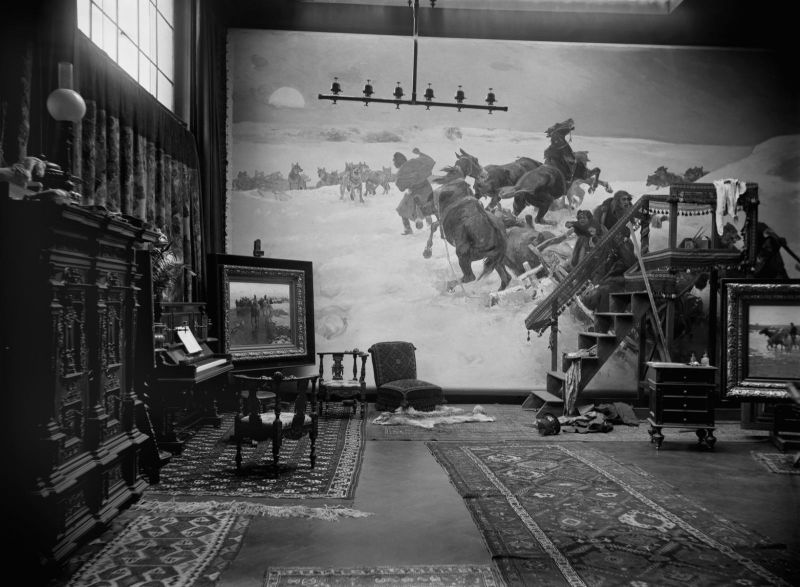Ateliers of Polish painters in Munich ca. 1890
Mediathek Sorted
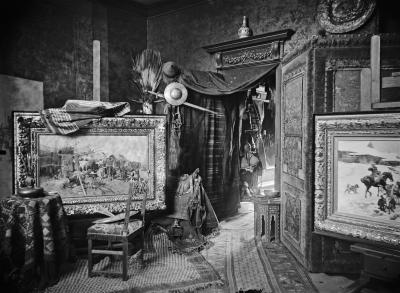
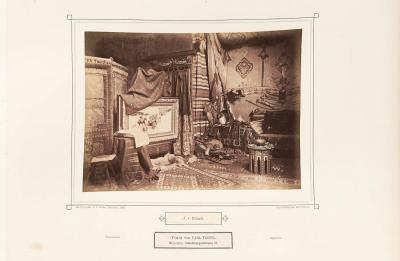

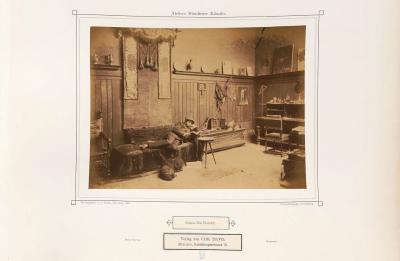






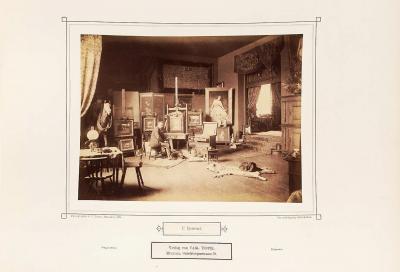




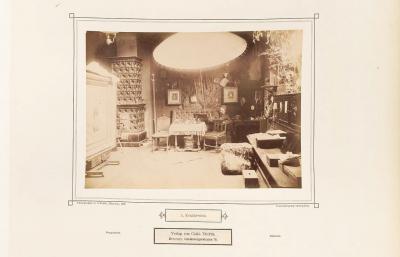


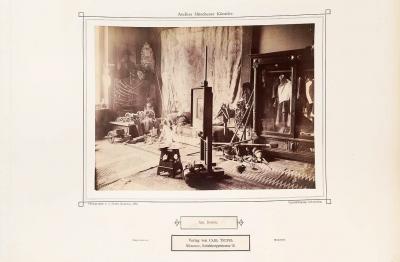



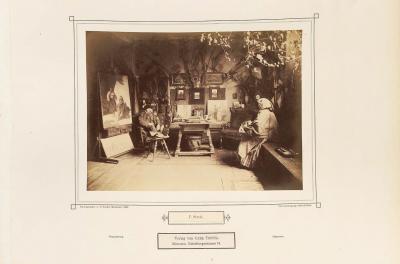

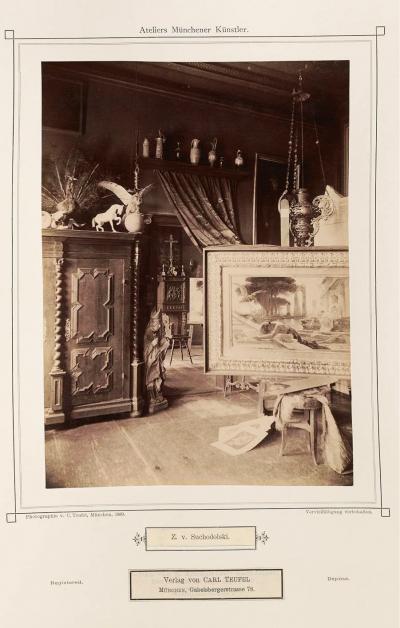

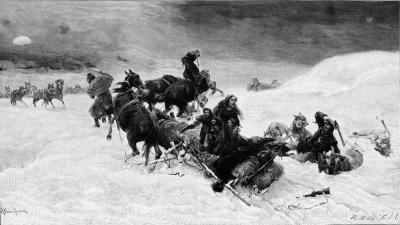


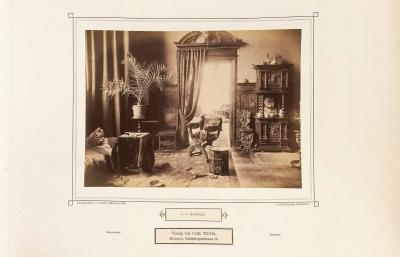
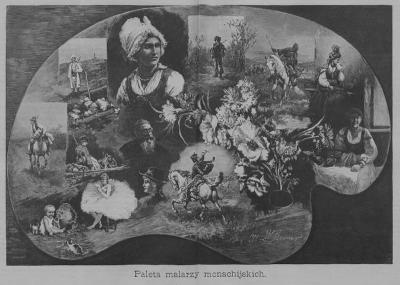


Wierusz-Kowalski, whose paintings initially followed the style of Brandt’s genre, equestrian and military scenes, followed by the hunting motifs of Maksymilian Gierymski, also used requisites from the pool in Brandt’s atelier for his subsequent riding motifs from the Caucasus and scenes from the January Uprising. From the beginning of the 1880s‑, he became known for winter scenes of wolf hunts and for coach and sled rids and portrayed, in particular, the pleasures of the Polish landed gentry on hunting trips and returning from the market. His atelier in Landwehrstraße was distinguished and furnished only with select historical pieces of furniture, oriental carpets and wall hangings. It was not a museum like Brandt’s atelier, instead, as well as being used for his art work, it was used as a place of representation, similar to the architecturally organised salon atelier of the portrait painter Papperitz, who resided only a few houses further along at Landwehrstraße 73. Only a Polish sled, which can be seen in the background on one of Teufel’s images (Fig. 22), relates to the painter’s art work and recalls the fishing boat that stood in Raupp’s atelier.
At over five metres high, the ceiling allowed the artist to paint paintings that were wall height, like the dramatic paining showing the attack by a pack of wolves on a team of horses, which Teufel had photographed whilst it was being painted in 1889 (Fig. 20). Only twenty years later, in May 1910, did Wierusz-Kowalski dare to exhibit the 5 x 10 metre large picture, which he showed in the Alten Rathaus in Munich’s Marienplatz. Prince Regent Luitpold and his family went to see the painting which, however, was largely overlooked by the public, presumably because it was no longer contemporary.[71] A reproduction was created as a wood engraving in the same year (Fig. 20a); the oil painting was destroyed by fire in 1920.[72] At the right-hand edge of Teufel’s image, an easel can be seen upon which is the painting “Team of horses crossing a ford”, which is now in the District Museum/Muzeum Okręgowe in Suwałki on loan from a private collection (Fig. 20b). Still to be definitively identified is the portrait of a hunter at the right-hand edge of Teufel’s second photograph (Fig. 21), which, when compared with a contemporary photograph, could be a portrait of Prince Regent Luitpold[73] or a picture of the Bavarian culture minister Freiherr Johann von Lutz (1826-1890), who Wierusz-Kowalski had previously portrayed on a painting that he gave to the Neue Pinakothek[74] and which today is missing.[75]
In 1871, even before Wierusz-Kowalski, Antoni Kozakiewicz (1841-1929) and Franciszek Streitt (1839-1890) came to Munich with the Polish painter Aleksander Kotsis (1836-1877). All three had been involved in painting the vaults in the mission church of Stradom near Krakow in 1862/63. From 1868, Kozakiewicz and Streitt had then studied in Vienna and travelled through Austria and the Alps with Kotsis. In Munich the three of them founded a painting atelier that is listed at Mittererstraße 7 in Ludwigsvorstadt in 1878,[76] and in 1890 is listed at Adalbertstraße 49 in Maxvorstadt spread over two floors.[77] Kozakiewicz,[78] who in Munich specialised in genre images and scenes from the rural areas and small towns of Poland and only returned to Warsaw in 1899, was an active member of the art scene around Brandt, was friends with numerous other Polish painters and was a member of the Munich Art Association from the beginning. His atelier room, as Teufel photographed it (Fig. 11-12), looks less prestigious but still quite picturesque thanks to a certain untidiness, green plants, palm fronds, a large Japanese parasol and some pistols and sabres on the wall. The painter is pressing himself rather modestly into a sofa corner and reading a journal. Resting on the easel is the framed picture of a “gypsy/Cyganka” at a camp fire, which the painter repeated several times in the decade following 1900.[79] Luitpold is also said to have visited this atelier several times. Kozakiewicz is represented in the “Album of Polish Painters” from 1876 by a bourgeois scene, “Nauki Babuni/A grandmother’s teaching”, in which a young girl learns the art of spinning (see PDF).
[71] Eliza Ptaszyńska in the online exhibition “Alfred Wierusz-Kowalski” in this portal, page 1, https://www.porta-polonica.de/de/atlas-der-erinnerungsorte/alfred-wierusz-kowalski
[72] Helpful information from Ms Eliza Ptaszyńska, Okręgowe Museum, Suwałki, October 2018
[73] Ferdinand von Miller and Prince Regent Luitpold at the chamois hunt, photograph, see Jooss 2012, page 162
[74] Ptaszyńska 2008, page XII
[75] Alfred von Kowalski-Wierusz: Minister of State Freiherr von Lutz at the chamois hunt, 1888, oil on canvas, 78 x 104 cm, Neue Pinakothek, Munich; was on loan to the Bavarian mission in Berlin but has been missing since the end of the Second World War (German Centre for Lost Cultural Items, http://www.lostart.de/Webs/DE/Datenbank/EinzelobjektVerlust.html;jsessionid=2F3FAC1E7A691FF4FCDCE1114C686211.m1?cms_param=EOBJ_ID%3D451581%26_page%3D35%26_sort%3D%24sort%26_anchor%3Did4440_eobjliste)
[76] Munich address book 1878, Part III, page 82 (Kozakiewicz), page 84 (Streitt)
[77] Munich address book 1890, Part I, page 184 (Kozakiewicz), page 357 (Streitt)
[78] Detailed biography in the Encyclopaedia Polonica, https://www.porta-polonica.de/de/lexikon/kozakiewicz-antoni
[79] One version of 1909 in the Auktionshaus Agra Art, Warsaw, http://www.agraart.pl/htdocs/english/new/objectn.php?idd=4172&aid=&off=0&curr=PLN&sch=1&ord=cu&s=1&gal=1&id_malarza=140, another one in the National Museum in Krakow/Muzeum Narodowe w Krakowie, 1909, oil on canvas, 82 x 54.5 cm, depicted in the Egzotyczna Europa exhibition catalogue 2015 (see literature), page 189





















































































